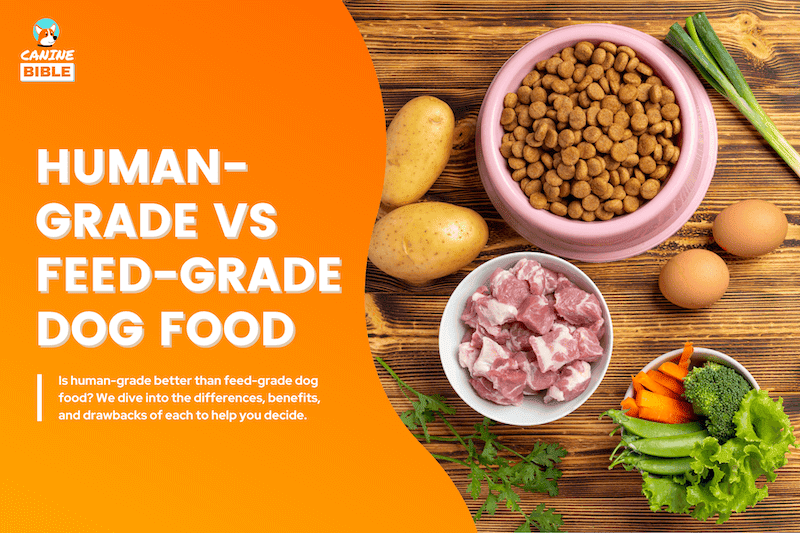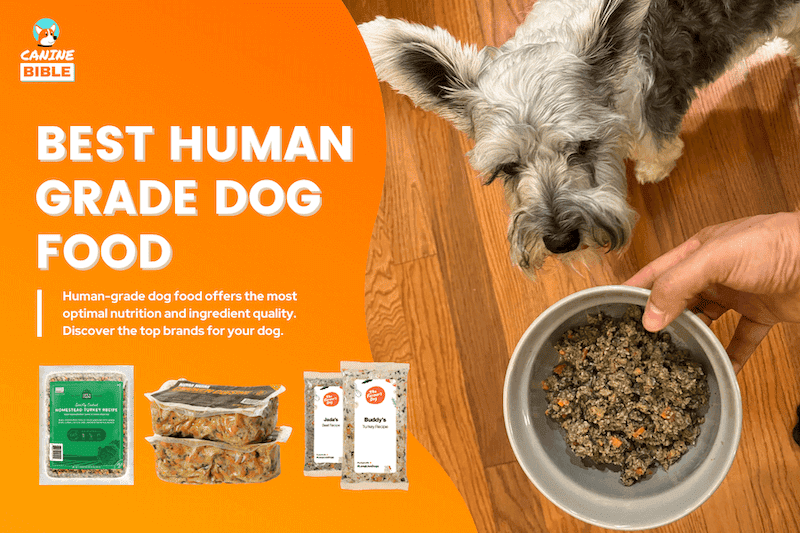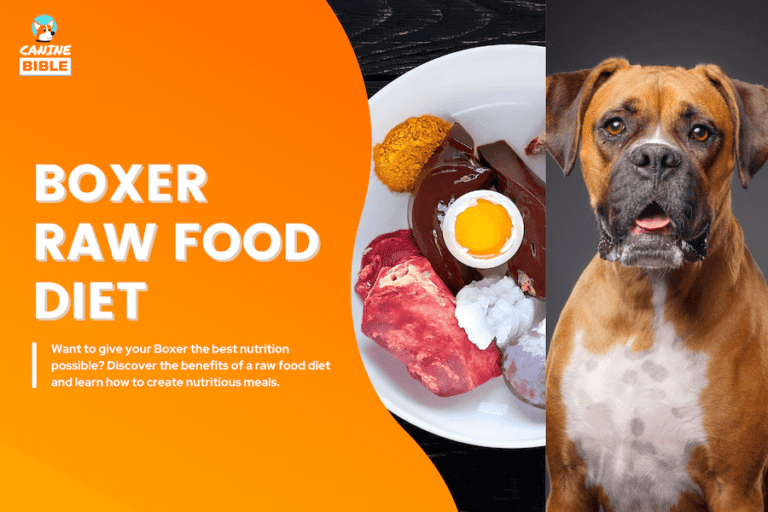Human Grade vs Feed-Grade Dog Food: Which Is Better? [Pros & Cons]

Canine Bible is reader-supported. We receive affiliate commissions via some of our links. This doesn’t affect rankings. Learn more.
This content was reviewed and fact-checked by veterinarian Dr. Sandra Tashkovska, DVM.
In recent years, the pet food industry has seen a surge in terms and labels that can sometimes confuse pet owners. Among these, “Human-grade” and “Feed-grade” are two terms that have garnered significant attention.
But what do these terms mean? And, more importantly, how do they impact the food quality we offer our beloved dogs? This comprehensive guide explains what they mean, including the pros and cons behind each so you can make the best nutritional choices for your dogs. Let’s get started!

What Is Human-Grade Dog Food?
“Human-grade” dog food is exactly what it sounds like – it’s food that meets the same quality and safety standards as the food we humans consume. This type of dog food is manufactured, processed and produced in adherence to the same USDA standards and FDA regulations as food produced for people. In other words, human-grade dog food is fit and safe for human intake.
For a dog food to be labeled or claim to be “human-grade,” the following standards must be met:
The United States Department of Agriculture (USDA) certifies manufacturers who meet these standards, allowing them to use the term “human-grade” on pet products. While the Association of American Feed Control Officials (AAFCO) AAFCO provides model regulations, each state can adopt, modify, or reject those as they see fit.[3]
Pet foods that do not meet human-grade standards previously stated are considered feed grade.Human-grade labeling requisites and regulations are complex and vary by state and locality. This may impede some pet food manufacturers from labeling their recipes human-grade even though they use human-grade ingredients.
What Is Feed-Grade Dog Food?
On the other hand, “feed-grade” dog food is a term used to describe pet food formulated and processed specifically for animals. This dog food category typically does not contain ingredients that meet the same stringent criteria required for human consumption.
Feed-grade dog food can include parts of animals that wouldn’t typically be found in human food. The AFFCO notes that feed-grade pet food may contain by-products, chemicals, animal organs, blood, fat, tendons, bones, fillers, and parts from “4D” meats (animals that are dying, diseased, disabled, or deceased).
According to the FDA, the “feed-grade” term in dog food means:
“Material that has been determined to be safe, functional and suitable for its intended use in animal food…”Notice how they use the word “material.” — This is legally allowed through rendering, a process that subjects the “material” to high heat and pressure to eliminate harmful bacteria.[4] When rendered, meat tissues and by-products are reduced to a gray, fatty mass, which is heated until fat and grease float on top. A final step is to dry the sludge to create a powder known as a meat meal. This powder is used to make feed-grade pet food.[5]
Feed-grade dog food is only legally allowed to be served to animals because this food contains ingredients that could harm humans. Feed-grade dog food doesn’t meet the same stringent standards for human consumption.
Is Human-Grade Dog Food Better?
Generally, human-grade dog food brands use higher quality ingredients than most commercially available dog foods (feed-grade pet food). The better companies that produce human-grade dog foods are more transparent about ingredient sourcing and manufacturing processes due to the stricter label requirements these brands are subject to by the FDA and AAFCO, making them inherently better in every aspect than traditional kibble.
Human-grade dog food typically far exceeds the minimum nutritional requirements set by AAFCO.There are health benefits associated with feeding this type of food to your dog, including superior nutrient and amino acid digestibility than feed-grade food.[6] Similarly, a study also found that lightly cooked human-grade vegan dog foods can have digestibilities exceeding 80% and be well-digested by dogs.
A study from the University of Illinois (UI) indicates that commercially available dog food made with human-grade ingredients results in less fecal output than kibble-based dog food.[7] This can be an indicator of better nutrient absorption and less waste production.
Human-grade food digestibility of dry matter, protein, fat, and other nutrients was significantly higher than dry kibble diets.[8]
This makes them better dog foods, but this does not necessarily mean they are good for your dog. Like any pet food decision, a close inspection of the brand and product is recommended. Human-grade dog food must adhere to stringent standards. While the term suggests superior quality, only a few dog food brands on the market meet these rigorous criteria. Read our best human-grade dog food review to learn who these are and more about the benefits of human-grade diets.
It’s worth noting when compared to feed-grade, human-grade food is also free from high levels of chemicals, pesticides and processed ingredients, which can make digestion more difficult and diminish the nutritional value of the ingredients.
Human-Grade Dog Food Drawbacks
Is Feed-Grade Dog Food Bad?
Feed-grade dog food is not inherently bad. Feed-grade dog foods are more affordable than human-grade and many feed-grade dog foods are formulated to meet specific nutritional requirements for dogs set by organizations like the Association of American Feed Control Officials (AAFCO).
According to the American College of Veterinary Nutrition, “most manufacturers [of commercially available pet foods] utilize sophisticated quality control and food safety mechanisms, including screening and reporting systems. Commercial foods remain a consistent, safe, and healthful option for feeding pets.”[9]
Feed grade formulas vary significantly between brands, but most commercial kibble, wet dog food and canned dog food fall into this category. The quality and safety largely depend on the brand, sourcing practices, and manufacturing processes.

The Problem With Feed-Grade Dog Food
The “Feed-grade” process allows dog food manufacturers to use animal by-products and even include sick or dead animal parts (4D meats) deemed unfit for human consumption through a process known as rendering (meat meals).[4]
Legally, food manufacturers can label a commercial pet food that uses 4D meats as “chicken” without providing further details about where that protein was sourced. Talk about mystery meat!
The main concern with feed-grade foods isn’t just about the quality of the meat used but also about what other ingredients, meat or not, are included. —and of course, pet food manufacturing companies wouldn’t advertise this. That is where the problem lies.
A 2004 Congressional Research Services report for the US Congress states that the industry has largely operated outside public view. However, meat rendering has attracted greater public attention since discovering bovine spongiform encephalopathy (BSE or mad cow disease).[10]
When buying feed grade, the key is to choose transparent brands regarding their ingredient list, where they source from, and their preparation procedures. As with any pet food choice, pet owners must research, read ingredient labels, and consult with a veterinarian to ensure they provide a nutritious and safe diet.
Feed-Grade Dog Food Drawbacks
Feed-Grade vs Human-Grade Processing
The processing methods employed in creating dog food are pivotal in determining its quality and safety. In this section, we will delve into the distinctions between feed-grade and human-grade processing, shedding light on how these practices impact the food that ultimately ends up in your dog’s bowl.
Human-Grade Processing
Human-grade processing methods aim to minimize processing steps to maintain the natural integrity of ingredients. This can result in fresher and more nutritious meals. Methods such as gently cooked, oven-baked, dehydration, or freeze-drying are typically employed by human-grade dog food brands to retain most of the nutritional quality of the ingredients, vitamins, minerals, and flavors.
Feed-Grade Processing
Extrusion is a common cooking process used in feed-grade pet food that involves mixing ingredients, cooking them under pressure and heat, and forcing the mixture through a die to create kibble shapes. While extrusion ensures that the food is safe to eat, it may not fully preserve the natural integrity of the ingredients.
About 95 percent of dry pet diets are estimated to be manufactured using “extrusion.”[11]The Dark Side of Extrusion In Dog Food
Here is what extrusion does to dog food, according to research.
Human Grade vs Feed-Grade Dog Food: Which One Should You Pick?
The nutrient standards set by AAFCO are consistent for all pet foods. This means that a “human-grade” pet food might not necessarily offer different nutrients than a conventional pet food. However, the primary distinction often lies in where the food is produced, how it’s produced, how it’s handled, and where the ingredients are sourced.
While dogs can live healthy and happy lives on feed-grade diets, they are not the best option.Under the current regulations, feed-grade pet food manufacturers are not subject to the same strict regulations as those for human-grade food. As a result, the processes, ingredients, and manufacturing practices for many feed-grade products are not up to the standards of human-grade products.
This is why we recommend opting for minimally processed and balanced diets, such as human-grade diets. This proactive approach ensures our dogs remain healthy and vibrant throughout their lives. It also helps minimize the adverse effects discussed above related to highly processed foods.
Choosing human-grade ensures that the brand follows FDA and USDA regulations, providing your pet with the best possible nutritional profile for their food.
While human-grade food can provide a higher level of confidence in ingredient quality and safety, individual pet dietary needs and preferences can vary. It’s essential to read the label, understand the ingredients, and consult your veterinarian to determine what’s best for your dog.
The Difference Between Human-Grade vs Feed-Grade
Below is a comparative table highlighting the key differences between feed-grade (traditional dog kibble) and human-grade recipes.
| Characteristics | Human-Grade Dog Food | Feed-Grade (Kibble) |
|---|---|---|
| Ingredients | Readily identifiable human-grade ingredients that you may cook for yourself. | Rarely identifiable and not suitable for human consumption. |
| Appearance | Most look like fresh dog food (a home-cooked meal). The ingredients (i.e., chicken, fruits & veggies) are visible to the naked eye. | Typically crunchy brown balls. Ingredients are not visible. |
| Shelf-stability | Not shelf-stable. Most human-grade foods must be refrigerated and frozen. However, a few dehydrated and kibble human-grade foods are shelf-stable and require no refrigeration. | Kibbles are usually shelf-stable for years. |
| Health benefits | Fresh and high-quality ingredients are associated with better digestion, stools, skin and coat, longevity and more. | Most kibble is starchy and full of fillers that break down to sugar, which doesn't contribute to good health. |
| Processing | Most don't use any preservatives or chemicals. Or are minimally processed. | Heavily processed with preservatives, additives and other chemicals. |
| Handling | Food is perishable and needs to be treated as real food. | Not perishable. |
| Sourcing | Ingredients sourced from suppliers, local farms, and other human food purveyors that meet USDA standards. | May source ingredients and supplements from other countries. |
| Serving | Needs to be thawed. Most packages come pre-portioned and ready-to-serve | Fill your pet's bowl with the desired amount. |
| Life stages | Available for all life stages. | Available for all life stages. |
| Cost | Higher than average. | Most affordable |
| Manufacturing facility | Prepared in USDA-approved human food kitchens in accordance with the FDA. | Pet food manufacturing facility. |
| Recipes | Every recipe uses clean USDA proteins mixed with fresh produce and balanced with vitamins and minerals. | Made up of material (i.e., by-products, meat meal) that has been determined to be safe, functional, and suitable for its intended use in animal food. |
| AFFCO | Exceeds AFFCO standards | Meets minimum AFFCO requirements. |
| Cooking process | Gently cooked, dehydrated and raw | Extrusion |
What to Look For In Dog Food
Human-Grade vs Feed-Grade Dog Food Pricing
The price of human-grade dog food recipes varies based on the company, dog weight (size), formula, and other factors.
According to Statista, for a decent mass-market kibble brand, you can expect to pay an average of $1.97 per pound of kibble. If you opt for a high-end kibble, the cost is around $3.45 per pound. Our team has calculated that the average price per pound for the most popular human-grade dog food brands is approximately $8.
Human-Grade Dog Food Price Comparison
To provide you with more insight into pricing, Nom Nom, a leading human-grade dog food company, has created a graphic that outlines the cost of their food. This data can give us a reasonably accurate estimate of what you might expect to pay for similar brands.
| Dog Size | Dog Weight (lbs) | Fresh Food Daily Cost | Fresh Food Weekly Cost (7days/week) |
|---|---|---|---|
| Tiny | Less than 10 lbs | $3 per day | $21 per week |
| Small | 10 – 20 lbs | $4 per day | $28 per week |
| Small/Medium | 20 – 30 lbs | $5 – $6 per day | $35 – $42 per week |
| Medium | 30 – 40 lbs | $7 per day | $49 per week |
| Medium/Large | 40 – 50 lbs | $8 per day | $56 per week |
| Large | 50 – 70 lbs | $10 per day | $70 per week |
*Prices will fluctuate depending on the brand you choose, but this is what you can expect to pay more or less.
Frequently Asked Questions
Feed-Grade Dog Food vs Human-Grade — Conclusion
Putting your dog on a human-grade diet is generally associated with better health. This eliminates low-quality ingredients, harmful additives, preservatives, and other chemicals from your dog’s diet.
Most human-grade dog food brands do not use extrusion. Instead, they rely on more natural cooking processes (such as gently cooked, raw, and dehydrated) that better preserve the nutritional integrity of the ingredients. Our research indicates that human-grade dog food tends to be superior to traditional kibble. We advise feeding your dog a diet that is minimally processed.
On the other hand, if you can’t afford human-grade food, feed-grade food may also be okay as long as is balanced and meets the AFFCO nutritional standard for your dog’s life stage.
Like It? Subscribe & Share!
Sources
Canine Bible uses only high-quality sources, including peer-reviewed studies, to support the facts within our articles. Read our editorial process and product review methodology to learn more about how we fact-check, test products, and keep our content accurate, reliable, and trustworthy.
- U.S. Food and Drug Administration. (2023). CFR – Code of Federal Regulations Title 21.
- New Hampshire Department of Agriculture, Markets & Food. (n.d.). Guidelines for “Human Grade” Claim.
- New Hampshire Department of Agriculture, Markets & Food. AAFCO Human Grade Standards for Pet Products. (2017, August 1).
- CFR – Code of Federal Regulations Title 21: PART 589—SUBSTANCES PROHIBITED FROM USE IN ANIMAL FOOD OR FEED. (2023, June 7). U.S. Food and Drug Administration.
- Landers, J. (2013). What Exactly Is in Pet Food? Sometimes, Dead Pets. Slate Magazine.
- Oba, P. M., Utterback, P. L., Parsons, C. M., & Swanson, K. S. (2020). True nutrient and amino acid digestibility of dog foods made with human-grade ingredients using the precision-fed cecectomized rooster assay. Translational Animal Science, 4(1), 442–451.
- Do, S., Phungviwatnikul, T., de Godoy, M. R. C., & Swanson, K. S. (2021). Nutrient digestibility and fecal characteristics, microbiota, and metabolites in dogs fed human-grade foods. Journal of Animal Science, 99(2), skab028.
- Tanprasertsuk, J., Perry, L. M., Tate, D. E., Honaker, R. W., & Shmalberg, J. (2021). Apparent total tract nutrient digestibility and metabolizable energy estimation in commercial fresh and extruded dry kibble dog foods. Translational Animal Science, 5(3), txab071.
- American College of Veterinary Nutrition. ACVN – Frequently Asked Questions. (n.d.).
- CRS Report for Congress. Animal Rendering: Economics and Policy (2004)
- Tran, Q. D., Hendriks, W. H., & van der Poel, A. F. B. (2008). Effects of extrusion processing on nutrients in dry pet food. Journal of the Science of Food and Agriculture, 88(9), 1487-1493. DOI: 10.1002/jsfa.3247.
- Riaz, M. N., Asif, M., & Ali, R. (2009). Stability of vitamins during extrusion. Critical Reviews in Food Science and Nutrition, 49(4), 361-368. DOI: 10.1080/10408390802067290.
- Craig, M. (2021). Additives in pet food: are they safe?. Journal of Small Animal Practice, 62(8). DOI: 10.1111/jsap.13375.
- van Rooijen, C., Bosch, G., van der Poel, A. F. B., Wierenga, P. A., Alexander, L., & Hendriks, W. H. (2013). The Maillard reaction and pet food processing: Effects on nutritive value and pet health. Nutrition Research Reviews, 26(2), 130-148. DOI: 10.1017/S0954422413000103.
- Singh, S., Gamlath, S., & Wakeling, L. (2007). Nutritional aspects of food extrusion: a review. International Journal of Food Science and Technology, 42, 916–929.
- Tran, Q. D., Hendriks, W. H., & van der Poel, A. F. B. (2008). Effects of extrusion processing on nutrients in dry pet food. Journal of the Science of Food and Agriculture, 88(9), 1487-1493. DOI: 10.1002/jsfa.3247.
- Hosbjerg, T. G. (2018, June 19). Probiotic Pet food – how is it done?. Bacterfield.
- Le Roux-Pullen, L., & Lessing, D. (2011). Should veterinarians consider acrylamide that potentially occurs in starch-rich foodstuffs as a neurotoxin in dogs?. J S Afr Vet Assoc, 82(2), 129-130. DOI: 10.4102/jsava.v82i2.47.
- Kumar, J., Das, S., & Teoh, S. L. (2018). Dietary Acrylamide and the Risks of Developing Cancer: Facts to Ponder. Frontiers in Nutrition, 5(14).
- Fay, M. A., & Kern, G. E. (1934). The Effect of Heat Upon the Biological Value of Meat Protein. Laboratory of Household Science, University of California, Berkeley. Received 11 July 1933, Available online 1 April 1934, Version of Record 7 March 2023.
- Tjernsbekk, M. T., Tauson, A.-H., Kraugerud, O. F., & Ahlstrøm, Ø. (Date not provided). Raw mechanically separated chicken meat and salmon protein hydrolysate as protein sources in extruded dog food: effect on protein and amino acid digestibility. Journal not provided. PMID: 28045202 DOI: 10.1111/jpn.12608.
- National Cancer Institute. (2017). Chemicals in Meat Cooked at High Temperatures and Cancer Risk.
- Harvard Health Publishing. (2018). Eating highly processed foods may raise cancer risk.
- Roine, J., Roine, M., Velagapudi, V., & Hielm-Björkman, A. (Year not provided). Metabolomics from a Diet Intervention in Atopic Dogs, a Model for Human Research? University of Helsinki.
Canine Bible authorship represents the unified voice of our entire editorial team and our in-house veterinarians rather than a single author. Each article, blog post, and review published under the Canine Bible name undergoes a rigorous review process, involving all team members to guarantee accuracy and up-to-date in accordance with the latest veterinarian research. This collaborative effort is an integral part of our editorial process and aligns with our four pillars of content creation. This approach ensures our content is backed by expert knowledge and factual information, offering our readers reliable, actionable, and trustworthy content.








